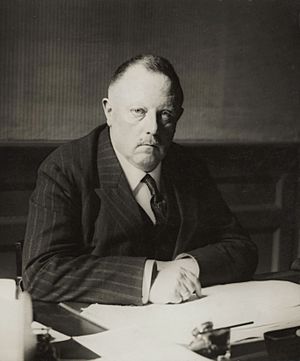Willem Hendrik Keesom facts for kids
Quick facts for kids
Willem Keesom
|
|
|---|---|

Willem Keesom in 1926
|
|
| Born | 21 June 1876 Texel, Netherlands
|
| Died | March 3, 1956 (aged 79) Leiden, Netherlands
|
| Known for | helium |
| Scientific career | |
| Fields | physics |
| Doctoral advisor | Johannes Diderik van der Waals |
Willem Hendrik Keesom was a Dutch physicist who made important discoveries about very cold temperatures. He was born on June 21, 1876, in Texel, Netherlands, and passed away on March 3, 1956, in Leiden. He is famous for being the first person to freeze liquid helium. He also helped us understand how tiny particles in matter interact with each other.
Contents
Amazing Discoveries in Physics
Freezing Liquid Helium
In 1926, Willem Keesom achieved something incredible: he found a way to freeze liquid helium. Helium is a gas that turns into a liquid at extremely cold temperatures, very close to absolute zero. Freezing it was a huge step in learning how matter acts when it's super cold.
Understanding Tiny Forces
In 1921, Keesom also created the first mathematical description for a type of force between molecules. These forces are called dipole–dipole interactions. They are sometimes called Keesom interactions because of his work. These forces help explain why different substances behave the way they do.
A Student of a Nobel Prize Winner
Willem Keesom was a student of Heike Kamerlingh Onnes. Kamerlingh Onnes discovered superconductivity, which is when certain materials can conduct electricity with no resistance at very low temperatures. For this amazing discovery, Kamerlingh Onnes won the Nobel Prize in Physics in 1913.
Discovering the Lambda Point
In 1930, Keesom made another important discovery. He found the lambda point transition. This is a special temperature where liquid helium changes from one state (Helium-I) to another (Helium-II). This change affects how helium behaves, especially how it conducts heat.
Recognition and Legacy
In 1924, Willem Keesom became a member of the Royal Netherlands Academy of Arts and Sciences. This is a group of top scientists and artists in the Netherlands. Many years later, in 1966, a small planet was named after him. It is called 9686 Keesom.
See also
 In Spanish: Willem Hendrik Keesom para niños
In Spanish: Willem Hendrik Keesom para niños

